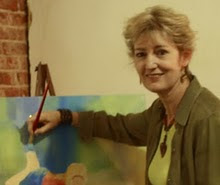If you have decided you want to do a house portrait painting, this series of lessons is your step by step.
Lesson #1 taught you how to plan out your painting, including working out the subject of your house portrait, determining the best angle and taking your photos. Now it’s time to decide on the best medium to use.
You can, of course, use any method you choose to depict your house -- from oil paints to pastels -- but from my experience, certain mediums work better than others for house portraits. It is important to include detail. If you were doing a portrait of a person, you would not leave out characteristic details of the person’s face. It is the same with a house. You want to include the details that show the unique personality of the home.
My preference for house portraits is a pen drawing followed by a watercolor wash. The line drawing records the finer points of the house and garden while the watercolor wash brings it to life. This enables you as the artist to create a detailed, attractive but subtle representation of the home and its garden surroundings.
You will need a good quality watercolor paper. These come in different paper weights (thicknesses) and are commonly available at any local art supply stores.
The first step is to draw out your subject in pencil. This requires an understanding of perspective so that the angles of the building are correct and look three dimensional. When doing a house portrait, nothing creates an amateur impression faster than crooked lines and a building that looks out of plumb. If necessary, study and master this skill before you draw your building. (You can find excellent books on perspective drawing in art stores, bookstores, libraries and on the internet.)
To make sure your drawing is accurate, use a tried and true method of dividing your main source photo into four quarters and then compare the content of each square with your pencil drawing (also divided in matching quarters) as you proceed. After you have done as many house portraits as I have, the pencil stage can be reduced down to broad strokes only, which includes making sure the drawing is correct compared to the source photo and the overall layout is balanced and attractive. At that point I move onto the pen work.
It’s up to you how detailed your pencil draft is and the big advantage is that you can use an eraser. But don’t go overboard with the eraser or you will end up scrapping off some of the surface of your paper in the process. What is important is that you feel comfortable with the pencil stage before moving onto your permanent pen drawing.
The next step is choosing the black pen you want to use. There are many different choices. Some artists like a fine ink stroke while others prefer the lines to be heavier. There is an abundance of quality art drawing pens on the market, most of them using ink cartridges, but with different size and types of nibs. Go to your nearest art supply store to get help in making your selection. Some artists prefer to use a thin tip felt pen or just an ordinary black ballpoint pen. If you plan to do a watercolor wash, make sure your chosen pen medium is water resistant. The only way to establish what works best for you is to try them out. That’s what I did many years ago and I established that my favorite tool is a simple black ballpoint. I found that one can perfect a fluid, more spontaneous look using a ballpoint, which is what I prefer.
Complete the pen work, starting with the main architectural lines of the roof and the walls. Then add shadowing and contrast, which is basically additional definition where needed. Use a set square or ruler on the key vertical and horizontal lines for a more professional final product. Include good contrast between differences in light and shadow to make your art work interesting and appealing. The standard I go for with my house portrait pen drawings is that the drawing is good enough to stand on its own as a piece of art, depicting the subject accurately and aesthetically.
In fact, some artists prefer to leave their pen drawing as it is rather than add a watercolor wash. Another option is to give the drawing a grey-tone wash. These creative choices are simply a matter of personal and artistic preference.
In my opinion, adding the watercolor wash adds life and character and helps to capture the unique personality of the home. With the pen and watercolor wash techniques you are combining two distinct art forms, pen drawing and watercolor painting, and, if done well, the result can be a vibrant mix of detail, accuracy and color.
My next lesson, Lesson #3, will cover how to apply the watercolor wash and complete your house portrait painting.
# # #
Leisa's artistic motto is Art with a Message. Her website stresses the importance of artists creating social change and includes an online gallery of landscapes and portraits. She specializes in house portraits, pet portraits, child portraits and original landscape paintings.
Contact Info:
Send an email
www.leisacollins.com





